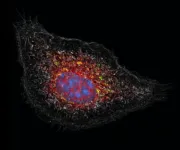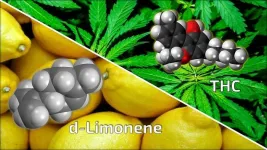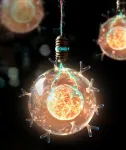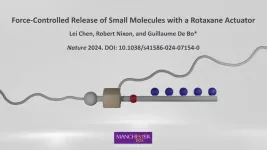(Press-News.org) Scientists, policy makers, and marine and environmental professionals across the world are being encouraged to sign up to a new initiative highlighting some of the global threats posed by light pollution.
The Global Ocean Artificial Light at Night Network (GOALANN) has been launched today at the United Nations Ocean Decade Conference in Barcelona.
It has been established by ecologists, oceanographers and social scientists who have spent more than a decade studying the impact of light pollution on the ocean, and the many species living in or near it.
The GOALANN network aims to expand on the impact of that work, unifying research groups from around the world to provide a central resource of marine light pollution expertise, projects and tools.
The idea is then for this information to be accessed by policy makers, environmental managers, maritime industries and others responsible for future decisions which may create or mitigate light pollution, as well as the general public.
Dr Thomas Davies, Lecturer in Marine Conservation at the University of Plymouth, is one of the co-leaders of the GOALANN initiative.
He said: “Ten years ago, we knew almost nothing about how much light pollution the oceans were exposed to, or the ecological harm this caused. We are beginning to answer these questions and uncovering the extent to which we need to make decisions that will help ecosystem recovery. However, light pollution is not receiving the same attention as climate change, ocean acidification, marine plastics or noise pollution. That urgently needs to change in the face of increasing coastal development, and an ever-growing global population, and we hope the GOALANN initiative will go some way to delivering that.”
Professor Tim Smyth, Head of Science for Marine Biogeochemistry and Observations at Plymouth Marine Laboratory, is also a co-leader of the GOALANN initiative. He added: “It seems that the more marine ecological indicators we look at, the more impacts we find of artificial light pollution. That includes having an effect on functions such as predator prey dynamics, reproductive cycles and disruption to the daily rhythm of life in the ocean. By launching this initiative, we hope to raise awareness of these threats and push the impacts of light pollution up the environmental agenda.”
Dr Davies and Professor Smyth, and others involved in the GOALANN network, have been involved in a number of impactful light pollution studies in recent years.
They showed that coastal cities leave up to 75% of the seafloor exposed to harmful light pollution, and that up to 1.9 million sq km of the world’s coastal waters are being exposed to biologically significant levels of artificial light at night.
They have also demonstrated the effects it can have on marine and coastal species, from crustaceans who rely on light from the moon and stars to find food, to coral reefs that have been tricked into spawning earlier than they should.
These findings and others were highlighted at the launch of the GOALANN network in Barcelona, with scientists hoping it will help better represent the issue of light pollution on the Ocean Decade agenda.
More information about the Global Ocean Artificial Light at Night Network is available at http://www.goalann.org/.
END
Initiative increases awareness of the threats posed by light pollution to the global ocean
The Global Ocean Artificial Light at Night Network has been launched at the United Nations Ocean Decade Conference in Barcelona
2024-04-10
ELSE PRESS RELEASES FROM THIS DATE:
How the body switches out of “fight” mode
2024-04-10
Joint press release of Charité and Uniklinikum Erlangen
Cortisone and other related glucocorticoids are extremely effective at curbing excessive immune reactions. But previously, astonishingly little was known about how they exactly do that. A team of researchers from Charité – Universitätsmedizin Berlin, Uniklinikum Erlangen and Ulm University have now explored the molecular mechanism of action in greater detail. As the researchers report in the journal Nature,* glucocorticoids reprogram ...
Physicists discover a novel quantum state in an elemental solid
2024-04-10
Physicists have observed a novel quantum effect termed “hybrid topology” in a crystalline material. This finding opens up a new range of possibilities for the development of efficient materials and technologies for next-generation quantum science and engineering.
The finding, published in the April 10th issue of Nature, came when Princeton scientists discovered that an elemental solid crystal made of arsenic (As) atoms hosts a never-before-observed form of topological quantum behavior. They were able to explore and image this ...
Researchers show chemical found naturally in cannabis may reduce anxiety-inducing effects of THC
2024-04-10
FOR IMMEDIATE RELEASE
A Johns Hopkins Medicine-led research team has added to evidence that a chemical found naturally in cannabis (also known as marijuana) can — in the right amounts — lessen the anxiety-inducing effects of tetrahydrocannabinol (THC), the primary psychoactive sister chemical found in cannabis. The finding has the potential to advance the medicinal use of THC, and reduce the risks of its recreational use in some people.
The substance, called d-limonene, is one of the most abundant terpenes, or essential oils, in the cannabis plant, and has shown promise in rodent studies in reducing anxiety behaviors. However, there has ...
AI-powered ‘sonar’ on smartglasses tracks gaze, facial expressions
2024-04-10
ITHACA, N.Y. – Cornell University researchers have developed two technologies that track a person’s gaze and facial expressions through sonar-like sensing. The technology is small enough to fit on commercial smartglasses or virtual reality or augmented reality headsets, yet consumes significantly less power than similar tools using cameras.
Both use speakers and microphones mounted on an eyeglass frame to bounce inaudible soundwaves off the face and pick up reflected signals caused by face and eye movements. ...
Newly found genetic variant defends against Alzheimer’s disease
2024-04-10
NEW YORK, NY (April 10, 2024)--Columbia researchers have discovered a genetic variant that reduces the odds of developing Alzheimer’s disease by up to 70% and may be protecting thousands of people in the United States from the disease.
The discovery of the protective variant, which appears to allow toxic forms of amyloid out of the brain and through the blood-brain barrier, supports emerging evidence that the brain’s blood vessels play a large role in Alzheimer's disease and could herald a new direction in therapeutic development.
“Alzheimer’s disease may get started with amyloid deposits in the brain, but ...
Serious flu damage prevented by compound that blocks unnecessary cell death
2024-04-10
As lung cells are killed by the influenza virus, they burst open, releasing molecular signals that trigger the immune cells that can combat the infection. This strategy can be an important red flag that something is wrong; however, if one cell death response, called necroptosis, continues unchecked, it can cause life-threatening injury to lung tissue. In a study published April 10 in the journal Nature, Tufts University School of Medicine scientists and collaborators present a newly developed compound ...
CHOP, Stanford researchers identify protein that controls CAR T cell longevity
2024-04-10
Philadelphia, April 10, 2024 – CAR T cell therapy has revolutionized the way certain types of cancer are treated, and the longer those CAR T cells live in a patient’s body, the more effectively they respond to cancer. Now, in a new study, researchers at Children’s Hospital of Philadelphia (CHOP) and Stanford Medicine have found that a protein called FOXO1 improves the survival and function of CAR T cells, which may lead to more effective CAR T cell therapies and could potentially expand its use in difficult-to-treat cancers. The findings were published online today by the journal Nature.
T ...
Race, ethnicity, and delayed time to COVID-19 testing among health care workers
2024-04-10
About The Study: In this cross-sectional study of health care personnel (HCP), compared with non-Hispanic white HCP and clinical HCP with graduate degrees, non-Hispanic Black HCP, non-Hispanic HCP of other races, and HCP of all other professional and education backgrounds were more likely to have delayed COVID-19 testing. These findings suggest that time to testing may serve as a valuable metric in evaluating sociodemographic disparities in the response to COVID-19 and future health mitigation strategies.
Authors: DaMarcus ...
Trends in deaths of despair by race and ethnicity
2024-04-10
About The Study: As of 2022, the midlife mortality rates from deaths of despair (deaths from suicide, drug overdose, and alcoholic liver disease) among Black individuals were higher than rates among white individuals, and rates among American Indian or Alaska Native individuals remained higher than rates in the other groups. Rising inequalities in deaths of despair among American Indian or Alaska Native and Black individuals were largely attributable to disproportionate early mortality from drug- and alcohol-related causes, which increased leading up to and during the COVID-19 pandemic.
Authors: Joseph ...
Revolutionary molecular device unleashes potential for targeted drug delivery and self-healing materials
2024-04-10
In a new breakthrough that could revolutionise medical and material engineering, scientists have developed a first-of-its-kind molecular device that controls the release of multiple small molecules using force.
The researchers from The University of Manchester describe a force-controlled release system that harnesses natural forces to trigger targeted release of molecules, which could significantly advance medical treatment and smart materials.
The discovery, published today in the journal Nature, uses a novel technique using a type of interlocked molecule known as rotaxane. Under the influence of mechanical force - such ...
LAST 30 PRESS RELEASES:
The (metabolic) cost of life
CFRI special issue call for papers: New Frontiers in Sustainable Finance
HKU Engineering scholar demonstrates the smallest all-printed infrared photodetectors to date
Precision empowerment for brain "eavesdropping": CAS team develops triple-electrode integrated functional electrode for simultaneous monitoring of neural signals and chemical transmitters during sleep
Single-capillary endothelial dysfunction resolved by optoacoustic mesoscopy
HKU three research projects named among ‘Top 10 Innovation & Technology News in Hong Kong 2025’ showcasing excellence in research and technology transfer
NLRSeek: A reannotation-based pipeline for mining missing NLR genes in sequenced genomes
A strand and whole genome duplication–aware collinear gene identification tool
Light storage in light cages: A revolutionary approach to on-chip quantum memories
Point spread function decoupling in computational fluorescence microscopy
BacPhase: Long-insert paired-end sequencing for bin marker construction and genome phasing
GmWOX1 regulates the mediolateral polarity of compound leaves in soybean
ChargeFabrica: An open-source simulation tool that aims to accelerate search for high performance perovskite solar cells
High levels of ADAR overexpression induce abundant and stochastic off-target RNA editing in rice protoplasts
On-demand upgraded recycling of polyethylene and construction of sustainable multifunctional materials based on the "LEGO" strategy
New "Stomata in-sight" system allows scientists to watch plants breathe in real-time
Anorexia nervosa may result in long-term skeletal muscle impairment
Narrative-based performance reviews deemed fairest by employees
New insights reveal how advanced oxidation can tackle emerging water pollutants
New review shows how biomass can deliver low-carbon gaseous fuels at scale
Climate change is quietly rewriting the world’s nitrogen cycle, with high stakes for food and the environment
Study finds SGLT-2 inhibitors linked to lower risk of diabetic foot nerve damage
Microbes may hold the key to brain evolution
Study examines how the last two respiratory pandemics rapidly spread through cities
Gender stereotypes reflect the division of labor between women and men across nations
Orthopedics can play critical role in identifying intimate partner violence
Worms as particle sweepers
Second spider-parasitic mite described in Brazil
January 2026 issues of APA journals feature new research on autism, pediatric anxiety, psychedelic therapy, suicide prevention and more
Private equity acquired more than 500 autism centers over the past decade, new study shows
[Press-News.org] Initiative increases awareness of the threats posed by light pollution to the global oceanThe Global Ocean Artificial Light at Night Network has been launched at the United Nations Ocean Decade Conference in Barcelona







